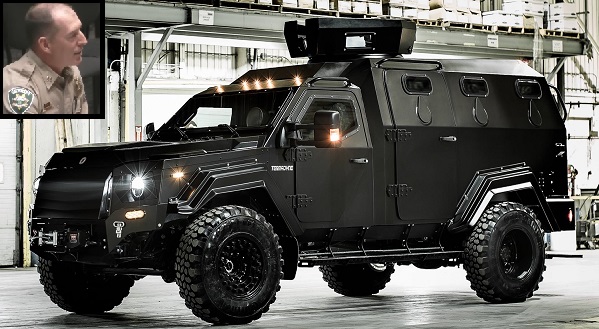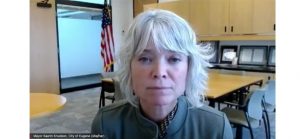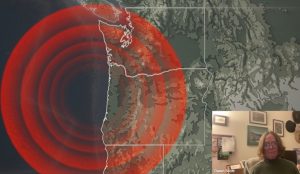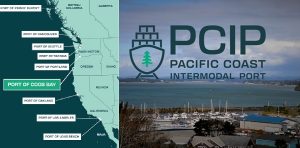County approves $400K Terradyne armored vehicle
9 min read
Presenter: Lane County approves purchase of a $400,000 Terradyne armored vehicle, the Gurkha MPV with a thermal imaging camera. On Oct. 22:
Capt. DJ Mann (Lane County Sheriff’s Office): We have a history going back about 30 years in the Sheriff’s Office using armored vehicles in some capacity.
[00:00:16] My earliest memories were in the early ‘90s. We got a bank transport truck, like a money truck, that was well, well used. The deputies fixed it up and that was our armored rescue vehicle. We got a complaint on the freeway because the exhaust would sometimes emit little droplets of diesel and people didn’t like to drive behind it. That’s all we had. That vehicle went away.
[00:00:38] We did have some support out of the Oregon Counterdrug Unit of the National Guard where they would bring eight-wheeled military vehicles down for planned search warrants if they met certain criteria and they had a drug nexus. So, those weren’t spontaneous calls, those were planned events.
[00:00:53] About 15 years ago we started getting the support out of the 1033 Military Surplus Program, and that is what has supplied our armored vehicles. Our office does own one armored vehicle, but it’s a rubber tracked—it’s like a skid steer. It’s more of a tractor. It lives on a trailer and it has to be taken to the scene.
[00:01:12] What we’re looking to buy is a truck. It’s basically about the size of an ambulance that is armored.
[00:01:18] Two of our armored rescue vehicles have been shot at, two separate calls in the last four years. I do have this souvenir, this memento that lives in my office. You can see the bullet strike here and here. This was a military surplus armored vehicle that was parked outside of Butler Road, when about 100 rounds were fired from within the interior out towards the deputies.
[00:01:41] One struck that brake canister on the front. There were deputies in the truck. There were deputies behind the truck. That’s just where one of the rounds went. Actually, it took a mechanic to come out and change that can out so it could be driven home at the end of the deal.
[00:01:54] This is defensive equipment that is our platform for de-escalation. And both of those shootings, the shooters were taken into custody without injury because we were able to use less lethal tactics from our armor, which is great.
[00:02:09] I feel we have great public support. I’ve spent a lot of time over the years at ‘Touch a Truck’ events and just community events where we often get asked to take a piece of armor for ‘Show & Tell.’ And the people seem very receptive because we use it responsibly and the folks that are just like, ‘Have you ever used this before?’ You get that kind of question. ‘Yeah, we have, and there’s one of the bullet strikes right there,’ and it’s an eye-opener.
[00:02:32] So, why do we want to get our own? We’d like one that’s purpose-built for civilian law enforcement. This truck that we want to buy is much easier to drive, has a lot better visibility for the operator, it’ll actually have heating and air conditioning that work, and that’s a big deal when it’s 100 degrees and you’re in body armor for several hours trying to negotiate somebody out of something.
[00:02:51] It has law enforcement-integrated features like a thermal imaging camera, so when you get to that rural area and you’re not sure if the subject is outside, we can scan the area and see if we can pick up the signature in the brush with the thermal camera.
[00:03:04] The military surplus vehicles have been a great asset, but they are prone to mechanical failure. We spend a lot of time keeping them running. They’re just not very reliable. They’re old. Some of them were actually built, like the Humvees, a couple of Humvees that we use. Those were vehicles that were built in the late ‘80s and then rebuilt by the military a couple of times. And by the time they got to us, I mean, they’ve had a lot of use. Obtaining the parts can be very challenging when these things break down.
[00:03:34] Here’s a real big reason we want our own, is: This Terradyne will not be subject to recall by the federal government. All it would take would be a presidential executive order and potentially all the agencies across the United States like us that rely on these vehicles, we’d have to potentially return them, and that would create a huge demand for the commercially-available one.
[00:03:58] Right now, if we order it today, it’s probably about nine months before we receive one. If you had all kinds of agencies trying to get their own, it could take years. And we just simply can’t do this kind of work without ballistic protection.
[00:04:10] This vehicle that we’ve chosen is the same vehicle that our neighboring counties, Deschutes County actually has their second one now, and they do have military surplus vehicles too. But they’re primary vehicle is this Terradyne now. Klamath County has one and Marion County just got one.
[00:04:26] So, how it’ll be used: It will be the primary vehicle, that’ll be the one we take when there’s an elevated risk of gunfire. We get a lot of ‘maybe calls,’ I call them, where you have some information, maybe the victim, or maybe even the suspect himself says, ‘You guys show up. I’m going to shoot it out.’ Well, you want to take something there that you’re ready in case they make good on that word.
[00:04:48] Thankfully, most the time that’s not what happens, but you don’t want to be nearly an hour away up a long county driveway in the middle of the night and have a patrol car ambushed when they said, ‘If they show up, we’re going to shoot it out.’
[00:05:02] This vehicle because it’s more efficient, it’s modern, it’s new, it’ll be easier to take to that kind of call, or at least get close to the area.
[00:05:08] How it will be used: We have a pretty stringent chain of command on this equipment. The sheriff himself knows when one leaves the garage, so we’re not worried about that command and control aspect. We expect it to be in service for probably 20 years. We’re not going to drive them very much.
[00:05:25] This vehicle’s not going to be driven around, just to be driven around. So it’ll live inside, it won’t get very many miles, as opposed to a patrol car that in four years might get 150,000 miles on it. We do intend to keep the military surplus equipment that we do have for those high-risk calls when multiple armored vehicles are needed.
[00:05:44] Often you just need to get a perimeter on the problem address or where the threat is. And you can’t really do that with one. In simple terms, it’s watching the front and the back door of the residence. You don’t want people out without protection, like at the Butler Road call where 100 rounds were fired.
[00:06:03] A couple of vehicles were used to contain the situation. And a small Humvee was used to actually escort the other occupants in the same multifamily building out to safety. So we used it to evacuate them from the dangerous area.
[00:06:23] The best example I can give about when you need multiple armored vehicles is back in 2015 when Deputy Todd Olson was seriously wounded. A few deputies went to a call and were immediately ambushed at night in a rural setting. The shooter fled in the brush with his rifle. What ensued was a multihour manhunt all night trying to, we had to go find him. There were other houses. We didn’t know if he was in the house at the scene at that time or they went to a neighbor’s or an outbuilding.
[00:06:54] So you had to do a lot of searching and obviously there was a massive law enforcement response, but you really need some armored vehicles at strategic locations and at least close by, so if the shooting starts erupting again, you can protect your people.
[00:07:08] And then because of the size of Lane County and the population, it’s pretty reasonable to believe that you could have two completely separate incidents that justify having an armored rescue vehicle at the same time.
[00:07:20] When small law enforcement agencies have these kind of problems, they call us because they don’t have these resources. So we frequently help out the smaller police departments.
[00:07:31] Commissioner Ryan Ceniga: On the Butler incident, there was multiple armored vehicles, wasn’t there (Yeah.) that ended up on scene?
[00:07:39] Capt. DJ Mann (Lane County Sheriff’s Office): Yeah. From the military we have a couple of very large trucks and then the two little Humvees, so. So that is a large truck, the Humvee, and then the Rook (the one that we own) that was used to push the garage door and because all the bullets were coming out from within behind a wall. You couldn’t shoot the shooter, you didn’t even know where the shooter was. It was just spraying out he knew where the deputies were.
[00:08:03] By taking that garage door down and using tear gas from the armored vehicle, it immediately ended it where he surrendered. First thing we saw were hands coming out. So a perfect resolution to a really, really bad situation.
[00:08:16] Commissioner Ryan Ceniga: So a vehicle that’s going to last 20 years, is it updatable?
[00:08:22] Capt. DJ Mann (Lane County Sheriff’s Office): Yeah, it’s a 550 Ford pickup chassis. They build it around that. They don’t change much. That’s why we like this design of this vehicle. They don’t alter the chassis. So, the driveline and everything stays pretty consistent with a proven package. So it should be very serviceable.
[00:08:42] Commissioner Pat Farr: Does EPD (Eugene Police Department) have a similar type of vehicle?
[00:08:44] Capt. DJ Mann (Lane County Sheriff’s Office): Yeah, they have a, they call it a Bearcat. They have two of them. Those are civilian law enforcement vehicles that they bought over the years. Yeah. The Sheriff’s Office just were pretty good at repurposing and doing with what we have available to us. So that’s why we’ve relied on the military surplus, but it’s really time to have a modern platform at this point.
[00:09:05] Commissioner Pat Farr: And I assume you do and I know that you do combined operations. So that you’d be able to support each other with your own.
[00:09:12] Capt. DJ Mann (Lane County Sheriff’s Office): Absolutely. They’ve supported us. We’ve supported them. I might have a picture of one of our vehicles towing their vehicle out of some mud, I think. Yeah, no, absolutely, it worked very well. And Springfield. Eugene is the only one that has the type of truck we’re trying to buy. Springfield has like a Suburban that’s armored.
[00:09:34] A lot of times it’s just finding the right piece of equipment for whatever the task is.
[00:09:40] Commissioner Laurie Trieger: I chatted with the sheriff just about this, what fund this is coming from, and it’s a combination of reserve, fleet funds, and some of the forfeiture funds.
[00:09:48] Capt. DJ Mann (Lane County Sheriff’s Office): I think probably our existing fleet, probably a 50-50 with seized drug asset money, will probably be a starting point.
[00:09:59] Commissioner David Loveall: Capt. Mann, I want to thank you for your service and especially for that citation above your right breast pocket, sir. Thank you again. I also want to say that this is an important vehicle for the public to understand. This is 2024; 40 years ago, the Autzen Stadium sniper was a threat.
[00:10:15] My uncle, rest his soul, was the sergeant in charge of the SWAT team, and they didn’t have an armored vehicle to breach that particular situation. So, in the moment of trying to get the public’s safety, they took and duct-taped all of their bulletproof vests to the front of a squad car and breached Autzen Stadium with that.
[00:10:32] So, your kinds of people, they do things on the fly that are both sacrificial and courageous and they make things happen when things usually don’t happen. So I think this is a well worthy expense for the safety of your people and for the safety of our community.
[00:10:44] So I move approval of a purchase order with the Terradyne Armored Vehicles, Inc. in the amount of $399,745 for the purchase and delivery of a civilian law enforcement armored rescue vehicle for use by the Sheriff’s Office during emergency response to high-risk calls for service involving the threat of gunfire.
[00:11:03] Presenter: The Terradyne Multipurpose Patrol Vehicle (MPV) is built for law enforcement and related government agencies only.




